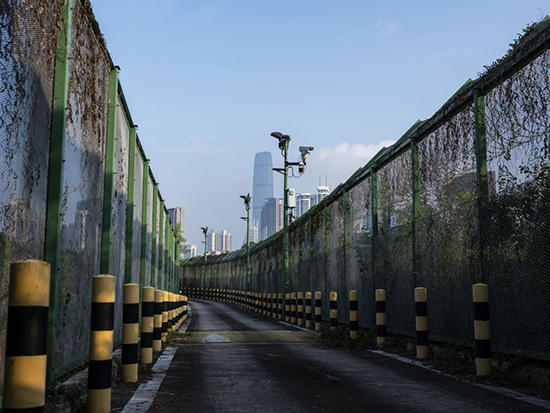深圳与香港:咫尺之隔,两个世界

|
去年年底开通的一条高铁线路,将香港和深圳中央商务区之间的旅行时间缩短至区区15分钟。但如果你乘坐这趟列车,你可能会觉得自己是在两个不同的世界之间穿梭。 在香港,就在距离红磡火车站只有几分钟路程的地方,混乱蔓延到这座城市拥挤不堪的街道上。与此同时,深圳没有任何骚动迹象。乘客们走下高铁,步入一座祥和而熠熠闪光的大都市:崭新的写字楼高耸入云、充满原始气息的公园让人心旷神怡、购物广场人头攒动,到处都是一派繁荣景象。中国最大的科技展会不久前在深圳举办,吸引了大批市民前往参观。 自1997年以来,践行“一国两制”政策的香港享有相对较大的自治权,一直是中国内地通往世界的一扇大门。然而,随着中国不断崛起,香港对内地的重要性迅速下降。而深圳一跃成为中国蓬勃发展的新科技中心,如今其GDP已经超过香港。 |
A high-speed rail line that opened late last year reduced the travel time between the central business districts of Hong Kong and Shenzhen to just 15 minutes. But if you rode that train it might have felt like you were moving between different worlds. In Hong Kong, just minutes from the Hung Hom train station, students were locked in pitched battles with police, with tear gas and conflict spilling out into the city’s densely-packed streets. In Shenzhen, meanwhile, there was no hint of tumult. Passengers emerged from the train into a calm and gleaming metropolis of new office buildings, pristine parks, and bustling shopping plazas. Some decamped for China’s largest tech fair, which Shenzhen hosted recently. Since 1997, Hong Kong has provided China with a gateway to the world as a global financial hub with relative autonomy under a policy called ‘One Country, Two Systems.’ Its importance to China, however, has rapidly diminished amidst China’s rise. Shenzhen, China’s booming new technology hub, now boasts a GDP that exceeds Hong Kong’s. |

|
深圳人普遍都很年轻,善于接受最新的科技进步,说普通话。这反映了一个事实:许多人都是从中国其他地方迁居而来的新移民。而香港正在步入老龄化时代。虽然很多香港人会说英语和普通话,但他们更喜欢讲粤语。 “两地的在线生态系统迥然不同,令人抓狂。每次跨越边境时,我的整个生活就全变了。”初创公司One Bag Tag的联合创始人扎克·比莱克这样说道。该公司在深圳设有办事处。“我用的SIM卡和支付系统都得更换。这就像穿越到另一个国度。” 如今,智能手机和先进的消费驱动技术早已成为深圳日常生活的中心。随着这座城市成长为中国的“硅谷”,深圳的科技进步速度之快远高于中国其他地方:无现金支付、人脸识别和人工智能技术不仅无处不在,而且已经融入日常生活之中。 长期以来,与深圳比邻而居的香港无疑是一座更加繁荣、更加先进的城市,但它近年来的科技进步相对缓慢,尤其是在消费领域。 多年来往返于香港和深圳的科技从业者伊森·伯格森指出,就技术而言,香港还“滞留在过去”。他说:“你会发现,人们在日常生活中仍然使用现金,那里的企业通常都不是以技术为导向的。”但在几分钟之后,“当你进入深圳那一刹那,”你就会清晰地看到这座城市对前沿技术的深度采用。“你一眼就能看出来。” 长期以来,中国一直致力于推行旨在整合香港、深圳和该地区其他城市的粤港澳大湾区计划。但随着智能手机和联网设备在塑造这些城市居民生活方面发挥着越来越大的作用,科技可能反而会扩大内地城市与香港之间的距离。 山寨和深圳速度 在过去短短的几十年里,深圳已经从一个仅有3万人口的小渔村华丽转型为一座拥有1200多万人口的全球科创中心。这项成就在很大程度上得益于中央政府的优惠政策、中国的经济开放和全球崛起,但它也跟深圳独特的精神底蕴密不可分。 从20世纪70年代开始,香港公司助力深圳建设一座航运码头,并充分利用这座城市廉价的劳动力资源。坐拥亿万身家的香港富豪就这样帮助深圳成为一个制造业中心。 这一发展促使时任中国最高领导人的邓小平于1980年将深圳划为经济特区,并给予其外贸和投资特权。深圳和邻近的东莞后来成为影响力遍及全球的“世界工厂”。 |
Residents of Shenzhen are young, receptive to the latest technological advances and communicate in Mandarin, reflecting the fact that so many are recent arrivals from the rest of China. Hong Kong is aging, and its people are generally suspicious that new technologies from China's mainland threaten traditions of democracy and privacy bequeathed them under British colonial rule. And while many Hong Kongers can speak English and Mandarin, the preferred dialect is Cantonese. “The entire online ecosystem is just so crazily different. Every time I cross the border, my entire life changes,” said Zach Bielek, co-founder of the start-up One Bag Tag, which has offices in Shenzhen. “The SIM card I use, the payment system. It’s like crossing into a new country. ” Life in Shenzhen now revolves around smartphones and advanced consumer-driven technologies. And as the city has become China’s ‘Silicon Valley,’ technological progress there happens at hyper speed compared to the rest of China: cashless payments, facial recognition, and artificial intelligence are not only ubiquitous but integrated into the fabric of daily life. In Hong Kong, long a far more prosperous and advanced neighbor, technological progress in recent years—especially in the consumer sphere—has been relatively slow. Ethan Bergerson, a tech worker who has worked between Hong Kong and Shenzhen for several years, says Hong Kong is “stuck in the past” in terms of technology. “You see people using cash, you see regular businesses that are not technology oriented,” he said. But just a few minutes away, the heightened adoption of cutting edge technology is clear “the second you come to Shenzhen,” Bergerson said. “You see it immediately.” The Chinese government has long been working on a Greater Bay Area plan to integrate Hong Kong with Shenzhen and other cities in the region. But as smartphones and connected devices play a growing role in shaping the lives of those cities’ residents, technology may be adding to the figurative distance between them. From shanzhai to Shenzhen speed In the last several decades, Shenzhen has gone from a small, fishing city of 30,000 to a global center of technological innovation with over 12 million residents. This has happened, in large part, due to a mix of preferential government policies, China’s economic opening and global rise, and the city’s unique spirit. Beginning in the 1970’s, rich Hong Kong tycoons helped convert Shenzhen into a manufacturing center, as Hong Kong companies contributed to the construction of a shipping terminal and took advantage of the city’s cheap labor supply. This development paved the way in 1980 for then-President Deng Xiaoping to label Shenzhen a Special Economic Zone (SEZ), granting the city privileged economic status for foreign trade and investment. Shenzhen and nearby Dongguan then became manufacturing hubs with factories sending goods all over the world. |

|
“不久之前,深圳还只是一个小渔村,而一水之隔的香港则是一座繁荣似锦的大都市,”位于香港的亚洲资本市场研究所的董事总经理Brian Tang表示。“深圳的发展速度着实让长期居住这里的人惊叹不已。” 许多人会嘲笑说,深圳是靠“山寨货”起家的。所谓“山寨货”,是指那些非法生产的廉价仿制品。尽管相当大一部分“山寨货”的确源自于深圳,但这段历史或许也为深圳注入了一种它今日赖以成功的创新精神。 “深圳很有创新精神,因为他们擅长混合搭配。”Brian Tang说。“深圳形成了一个生态系统,尤其是在硬件方面,很多工厂都有正式或非正式的联系,从而催生大量创新。” 这些工厂的亲密关系让深圳成为了科技初创企业茁壮成长的沃土。许多中国最大的科技巨头——包括华为和中兴这样的电信公司、社交媒体公司腾讯,以及世界最大的基因测序公司华大基因——都起源自这座城市。 |
“It wasn’t that long ago that Shenzhen was just a fishing village, and Hong Kong was the prosperous one across the water,” said Brian Tang, managing director of the Asia Capital Markets Institute in Hong Kong. “People who have been here long enough marvel at the rate it has grown.” Many would deride Shenzhen’s initial development as shanzhai, a Chinese term derogatorily used to refer to illegally-produced cheap imitation goods and knock-offs. While Shenzhen produced its fair share of shanzai goods, that stage of its history may have also instilled the innovative spirit that today has helped the city succeed. “[Shenzhen was] very innovative because they were mixing and matching,” said Tang. “Shenzhen developed an ecosystem, especially in hardware, where a lot of the factories were formally or informally linked, and that led to a lot of innovation.” Proximity to these factories made Shenzhen a ripe place for technology startups to grow and flourish. Many of China’s largest technology giants—including telecommunications firms like Huawei and ZTE, the social media firm Tencent, and the world’s largest gene-sequencing company BGI—all trace their roots to the city. |

|
凭借“深圳速度”(意指在极短时间内完成一款产品从研发到上市销售的所有环节),这座城市持续蓬勃发展,成为中国各地初创企业、投资者和科技工作者竞相涌入的科创中心。 “深圳简直是一个无与伦比的存在。”比莱克说。“在一款产品的开发阶段,你可以找到任何东西,并且在一天之内就能够得到它。这真是个奇迹。” 这种创新精神也促使该市迅速采用一系列新兴技术。伯格森说,深圳的一些写字楼利用面部识别摄像机扫描员工的面部,从而避免繁琐的安检流程。电梯门随后自动打开,并将员工送到各自工作的楼层。 创新能力的差距 另一方面,香港一度是消费驱动技术创新的全球领导者。但现在,它在采用无现金支付等新兴技术方面进展缓慢,并且越来越抵触像脸部识别这类技术。 早在1997年9月,香港地铁公司就推出八达通卡——一款嵌入自动支付系统的地铁卡。这在当时是一项开创性技术。随着数以千计的商店采用八达通支付系统,这张地铁卡迅速风靡香江,成为市民生活中不可或缺的一部分。然而,时至今日,即使地铁已经进入无现金支付和面部识别时代,八达通卡仍然占据着统治地位。 “香港曾经远远领先于世界其他地方,但后来就停滞不前了。”Brian Tang坦言。这是因为香港的创新努力通常集中在消费以外的领域。他补充说:“香港的传统优势是连接世界与中国,尤其是金融领域的连接。” 事实上,香港的优势在于其金融业。尽管最近动荡不断,但这座城市仍然是中国与世界其他地区的重要金融纽带。因此,香港的技术创新并没有把重点放在消费者身上,而是专注于银行和金融技术。 然而,就硬件而言,香港根本无法与深圳竞争。一个广为流传的故事是,2006年,汪滔在香港科技大学的卧室中创办了一家名为“大疆创新”的无人机公司。但他并没有留在香港,而是选择前往深圳发展业务。随后,大疆创新迅速发展成为全球最大的消费无人机公司。 香港科技大学技术转移中心主任邝伟权认为,软件初创企业仍然可以在香港取得成功。“在香港,货币能够自由流动,这个优势有助于初创企业吸引国际投资者,并走向国际市场。” 在消费层面,你很难说香港人反对技术进步。官方信息显示,香港的智能手机用户约占总人口的75%,这一比例甚至高于内地。但近几个月来,新科技在香港受到了巨大的打击,街头的面部识别摄像头大量被破坏。 此外,中国内地用的是微信、滴滴出行和大众点评,而香港人更爱使用WhatsApp、Uber和Deliveroo。尽管深圳和香港几乎共享着同一片土地,但实际上,这两座城市已经疏离,渐行渐远。(财富中文网) 译者:任文科 |
With ‘Shenzhen speed’ or the idea that the city brings a product from development to execution in record time, the city has continued to boom, becoming a hub for startups, investors, and tech workers from across China. “There’s nothing like it," said Bielek. “In the developing stages of a product, you can find anything, and get it all within one day. A miracle story.” This innovation has also led the city to quickly adopt emerging technologies. Bergerson says that at some Shenzhen offices, facial recognition cameras scan faces of employees to bypass security, automatically open elevator doors, and take them to the floors they work on. From innovation to skepticism Hong Kong, on the other hand, was once a global leader in consumer-driven technological innovation, yet today has been far slower to adopt newer technologies like cashless payments, and is increasingly defiant to ones like facial recognition. In September 1997, Hong Kong’s subway line—the MTR corporation—launched the Octopus card, a subway card embedded with an automatic payment system. At the time this was groundbreaking technology, and it became indispensable to life in Hong Kong as it spread across the city with thousands of stores adopting Octopus payment systems. Today, however, even in the age of cashless payment systems and facial recognition on subways, the Octopus still reigns supreme. “They were way ahead of the rest of the world, but then they just stayed there,” said Tang. That’s because Hong Kong has generally concentrated its efforts at innovation on sectors outside the consumer sphere, he adds: “Hong Kong’s traditional strength is linking the world to China and to the financial industry here in China.” Indeed, Hong Kong’s strength lies in its financial industry, and for all of the city’s recent unrest, it remains a critical financial link to the rest of the world. So rather than focusing on consumers, the city’s technological innovation has been geared towards its banks and financial technology, even hosting a fintech conference last week. For hardware, however, Hong Kong simply cannot compete with Shenzhen. In 2006, Frank Wang famously founded a drone company called DJI from his bedroom at the Hong Kong University of Science and Technology. Yet instead of remaining in Hong Kong, Wang chose to build his business in Shenzhen where it quickly emerged as the world’s largest consumer drone company. Alex Kwong, head of Hong Kong University of Science and Technology’s Technology Transfer Center, believes that software startups can still succeed in Hong Kong: “The free flow of currencies [in Hong Kong] is an advantage and helps startups attract international investors to go to the international market.” On a consumer level, Hong Kongers are hardly luddites. The city boasts an even higher level of smartphone users, at roughly 75% of the population, than in the Mainland, according to Hong Kong’s government.But in recent months, protesters have shown that for Hong Kong, a march to technological innovation is also cause for concern. They have gone to great lengths to protect their privacy using encrypted messaging apps, and even smashed facial recognition cameras on the city’s streets. Ultimately, the greatest difference may be that residents of the two cities simply do not share any common virtual space. China’s mainland has Wechat, Didi Chuxing (ride-hailing), and Dianping (food delivery), while Hong Kong has WhatsApp, Uber, and Deliveroo. So while people in Shenzhen and Hong Kong share nearly the exact same land, the two cities are virtually drifting farther apart. |













